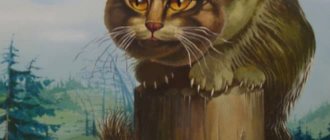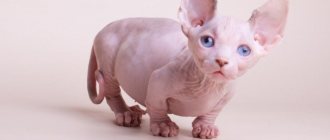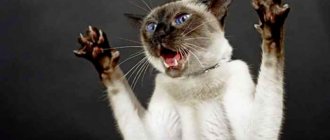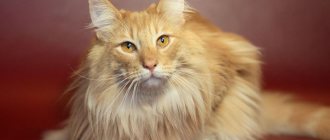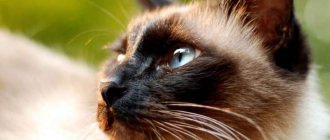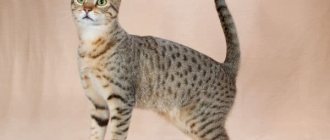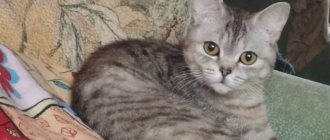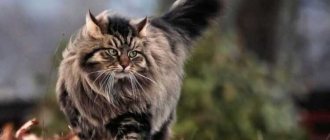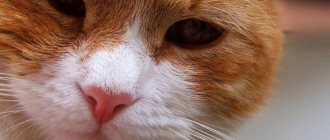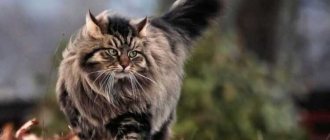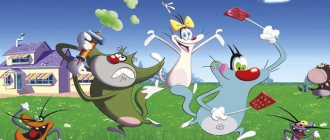Cats have rightfully earned the title of the most popular pets. The sectioners did a good job and bred many strange breeds. Today you can meet both real giants and miniature babies who, even despite their advanced age, can look like kittens. Miniature cats are distinguished not only by their weight and size, but also by their very eccentric appearance. Even ardent opponents of keeping pets in an apartment admit that these cute creatures have grace and charm. Such four-legged neighbors do not take up much space in the house and allow breeders to save on food. A rating of miniature cats with photographs and descriptions is presented to site visitors. The list included representatives with an average body weight of no more than 3.8 kilograms. Depending on the price, it is divided into 3 main subgroups.
A cat named Fizz Girl from the dwarf munchkin breed was included in the Guinness Book of Records. She is 6 inches (15.24 cm) tall and weighs 2 kg. The cat lives in California (USA).
Origin of dwarf cat breeds
If in cynology decorative dog breeds are thoroughly balanced by service, hunting and numerous companion dogs, then felinology has been developing exclusively in the direction of decorativeness for a long time. No, really, an elite purebred cat from a good home will not hone its working skills in catching mice and rats - where can I get them, in a good home? An exclusive bright appearance is much more valuable, and all the efforts of breeders are aimed at improving it.
Decorative dwarf cat breeds are becoming increasingly popular in the world
In the last twenty to thirty years, a new trend has emerged - the breeding of cute, touching and funny dwarf cats, which until old age remain eternal kittens both in appearance and in behavior. Fashion determined demand, demand gave birth to supply - breeders in Europe and America began to develop new breeds according to a single principle: the smaller and funnier the cat, the better.
There have been many attempts, but not all of them were successful - now we can name up to one and a half dozen more or less mature young breeds of baby cats, and most of them are of American origin. Almost all of them are the result of either gene mutation or hybridization; only, perhaps, the Singapore cat can be classified as a native breed.
The Singapore cat is the only native dwarf breed
Rare dwarf breeds still have many disadvantages, the main ones of which are:
- instability;
- limited gene pool;
- lack of knowledge of hereditary pathologies.
Video: Lilliputians of the cat world
Skookum
The breed of the smallest cat, despite its dwarf size, does not necessarily have to have a fragile, miniature body.
She may have strong and well-developed muscles.
This statement is true for the Skookum breed, which translated into Russian means “unbending.”
The history of Skookums begins in 1996, when the first descendants of crossed Munchkins and La Perms appeared.
Their creator is the American breeder Roy Galusha, who for a decade has been trying to breed a small breed with wavy hair.
Skookum
Even in the photo it is noticeable that representatives of Skookum have a strong body, with well-developed muscles.
Interesting fact! Because of their curly fur, Skookums are also called “dwarf la-perm.”
In 2006, TICA recognized the breed as experimental.
In Australia, Skookum has already been able to win the WNCA champion title.
The weight of dwarf fluffies varies from 2 to 4 kg.
Mini cat breeds
Size matters! Dwarf cats are becoming more and more in demand - they are rare, often very expensive breeds. The cost of a kitten in some cases can be estimated at tens of thousands of dollars. Being the owner of a Minik is fashionable and prestigious, and it is unlikely that these special, elite breeds will ever gain widespread popular popularity.
However, these charming little ones are unlikely to suspect their exclusivity. All of them are just cats who love their owners and know how to create a special atmosphere of comfort and joy in the house.
Dwarf cats, variety of breeds - photo gallery
Singapura descended from Singaporean stray cats
Bambino is a cat who remains a child until old age
The Munchkin is the shortest cat breed in the world
Lambkin is an experimental cross between a Munchkin and a Selkirk Rex.
Dwelf was obtained from a triple selection of Munchkins, American Curls and Canadian Sphynxes
Skookum: his paws are from a munchkin, and his fur is from a la-perma
Miskin is a hairless breed obtained from crossing Munchkins and Scythians. Scythian toy bob is faithful and devoted, like a dog.
Genetta is a cross between a Munchkin and a Bengal and a Savannah cat.
Napoleon received the name of the French emperor, who was also short in stature
Kinkaloo - the fruit of love between American curls and munchkins
The Balinese cat (Balinese) is descended from the long-haired Siamese.
Munchkin: 1.8 – 4 kg
Munchkin
Representatives of this breed are the dachshunds of the cat world: they have very short legs. Munchkins were not specially bred; the first representative was found by accident, and it was a natural mutation. In the 40s, the short-legged cat gave birth to the same dachshund-like kittens, which were completely healthy, then the breed gained a foothold and began to gain popularity. At the moment , these cats are considered the shortest , the minimum height was recorded as 13.34 cm. An adult cat can weigh between 2.7-4 kg, a cat - 1.8-3.6 kg.
The Magnificent Seven - top-7 smallest cats
The fashion for exclusive dwarf cats stimulates enthusiastic breeders to actively work on creating new mini-breeds, many of which are the result of hybridization of funny short-legged munchkins with various domestic cats:
- with the Persians and exotics - Napoleon;
- with sphinxes - miskin and bambino;
- with Selkirk Rex - Lambkin;
- with laperms - skukum;
- with savannas and Bengal cats - genetta;
- with American curls - kinkalow;
- with curls and sphinxes - Dwelf.
Munchkins have become the genetic basis for many new breeds of mini cats
The process is proceeding with varying degrees of success, and the small fruits of great cat love and selection are causing a record number of discussions among felinologists and animal rights activists. Many of the resulting breeds still remain in experimental status; they are not recognized by international organizations. And in Germany, munchkin hybridization was officially banned.
Munchkin
The famous short legs of munchkins are not experiments of breeders, but a consequence of a genetic mutation. The popularity of adorable short-legged cats is growing rapidly - in just over thirty years the breed has become famous and in demand throughout the world.
Munchkin in his famous pose: sitting on his butt and resting his tail on the floor
The smallest of the munchkins, the famous Lilliputian cat, listed in the Guinness Book of Records, was only 13.34 centimeters tall at the withers. And the largest munchkin will not weigh more than four kilograms. These cute kids, in addition to all their other advantages, have a wonderful character:
- attached to the owner like a dog;
- self-sufficient and unobtrusive;
- easily adapt to new places and unfamiliar people;
- They respond well to training.
It’s hard to believe, but all modern miracle munchkins are descendants of a stray cat, which a kind woman took pity on in 1983. American Sandra Hochenedel discovered a black and white short-legged cat, hungry and pregnant, under her old van. Considering the animal crippled, Sarah took her in and named her Brambleclaw. To the amazement of the owner, Brambleclaw soon gave birth to short-legged kittens - they became the ancestors of the munchkins.
Video: munchkin cat
Bambino
The word "bambino" is translated from Italian as "child". This pink warm charm really remains a child for life, small and funny. Short-legged hairless cats are unique in appearance and genetics and require increased human attention.
Bambino - the eternal child
The weight of an adult animal cannot exceed three to four kilograms. Bambino skin is unusually delicate, thin and soft; She is completely bald or covered with light down. They are very sensitive to cold and sunburn, so these cats usually have a varied wardrobe for all seasons. They need to be bathed more often than “hairy” cats, and their ears and eyes should be cleaned more thoroughly. And bambinos are incredibly positive animals:
- very active and playful;
- good-natured and attached to children;
- they love their owner tenderly;
- love to hug with the whole family.
Like many dwarf cats, the “eternal child” is the result of munchkin hybridization. The second progenitor of the new breed was the dwarf sphinx. This interesting combination gave Bambino quite good health, which sets him apart from some other experimental “minis”.
Video: bambino cat - and a kitten in old age
Skookum
A miniature cat with curly hair and short legs; obtained by crossing munchkins with curly fluffy lapermas. The breed of American selection is very young, and it still has a long way to improve. Translated from one of the Indian dialects, “skukum” means “brave, fearless” - that’s what he is, this small but proud cat.
Skookum - small but very brave
This compact and strong cat should weigh no more than three to four kilograms; she has a round head and very expressive eyes. This breed has no restrictions on eye color and coat color. The main exclusive feature of Skukum is its beautiful curly fur, which can be both short and long and requires special care. In all other respects, this little cat is quite unpretentious in keeping, and in terms of his character he is a complete pleasure:
- cheerful and cheerful;
- loves to play, but does not play pranks;
- gets along easily with all the inhabitants of the house;
- brave, inquisitive, but not aggressive.
The author of the funny breed was the American Roy Galush, who single-handedly began to actively engage in breeding work back in the 90s. Only twenty years later did European, Australian and New Zealand breeders join in the development of the new mini-breed.
Video: curly skookum
Lambkin
One of the rarest cats in the world - small, rare, fluffy and very charming. There are only a few dozen such animals today, and the experimental breed has not yet been recognized by international felinological organizations - it still has to develop and improve.
Lambkin - lamb in cat's skin
Short legs, a miniature fluffy body and a magnificent tail - that’s what a lambkin is like. He needs to be brushed very often, bathed and even cut from time to time. These cats, even at the first meeting, are remembered for their expressive looks and golden character:
- very affectionate;
- tolerant and friendly;
- get along well with small children and any pets;
- cheerful and sociable.
The name “lambkin” is no coincidence - it literally means “lamb”, this is how this adult kitten is called for its gentle, easy-going disposition and, of course, for its soft curly fur coat. He is also often called an angel, and this is also completely true.
Video: lambkin cat, cute and fluffy
Kankalow
The cartoonish appearance of the Kinkalow will not leave anyone indifferent: short legs, curved ears and an incredibly funny face - this is a miracle that will forever remain small. Interest in this dwarf breed of American origin is growing, but it is very young and has not yet received recognition.
Kankalow is a cartoon cat with difficult genetics
An adult kinkalow weighs up to three kilograms and has a bright “cartoon” appearance: short legs and curved ears create a unique, funny image of this cat. The cute appearance harmoniously combines with the good character that this cat pleases its owners:
- cheerful and good-natured;
- sweet and pretty;
- persistent and inquisitive;
- sociable and attentive.
Kankalows have very complex genetics, inherited from both parents - Munchkins and American Curls. Not all kittens in a litter receive the genes that are responsible for short legs and curled ears - only one or two babies are born “pure” Kinkaloo. So the reproduction of this interesting breed will not proceed quickly, and it will remain among the rare and very expensive for a long time.
Video: Kinkalow - a breed that will remain rare for a long time
Skiff toy bob
A young domestic mini-breed first appeared in Rostov-on-Don. Its creator, head of the Kuts nursery, Elena Krasnichenko, worked for thirty years to consolidate the best breed qualities, form and select the population. What happened as a result? A very small point color cat with a short tail and huge blue eyes, the average weight of an adult animal is one and a half kilograms!
The Scythian toy bob is distinguished by its short stature and short tail.
The Scythian Toy Bobtail is the result of a specific gene mutation in the Thai (Mekogonian) Bobtail, which determined the tiny size of the resulting animals. These are practically pocket cats, the size of a four-month-old kitten of an ordinary breed, and have an amazing character:
- overly inquisitive;
- very attached to the owner;
- do not scratch, but can bite in defense;
- are willing to train.
It is interesting that cats of this breed do not mark their territory, and therefore they do not have a specific musky odor.
Video: Scythian toy bob - a cat with the habits of a dog
Singapore
It's impossible to believe that Singapura - the height of perfection and elegance - comes from marginalized street children, but it is so. Mysteriously, on the island of Singapore, a unique population of semi-wild street - or rather, sewer cats - has developed, which mainly lived in sewer pipes, like ninja turtles. Miniature, big-eyed, shy - these animals were in danger of extinction, but then one American tourist businessman noticed them...
Singapura lived not so long ago... in sewer pipes
Representatives of the young dwarf breed weigh two to three kilograms, have an elegant, muscular body, covered with short, smooth hair, shining in unusual pinkish shades. This cat is unusual both in its character and behavior:
- timid and impressionable;
- careful with strangers;
- delicate and unobtrusive;
- smart and very clean.
One of the clear advantages of this breed is its good health and resistance to infectious diseases. Singapuras are long-lived, and the only thing that is really dangerous for them is drafts.
Video: Singapura - a small cat with big eyes
First place – skif-tay-don
The first kitten of this breed appeared in 1988 in Rostov-on-Don. A Thai Bobtail breeder crossed a Thai cat with four kinks on its tail and a Thai cat with a non-standard donut-shaped tail. As a result of this mating, the founder of the breed was born, who was named Kutsy. In 1994, the first Scythian-Tai-Don breed standard was approved. Adult cats weigh from 900 g to 2 kg.
Miniature cats are a real decoration for every home. But remember that they need special, careful care. Because small pets cannot fend for themselves. Under no circumstances should such a cat be allowed out for a walk unattended.
Buying a dwarf kitten
It’s hard to remain indifferent at the first glance at a touching little cat—a completely natural thought immediately arises: “And I want one like that...”.
It's impossible to remain indifferent to these little cuties.
How to decide on the breed
If you have seriously decided to engage in exhibition and breeding activities with cat minis, then such a desire is unlikely to have arisen spontaneously: you have probably already thoroughly prepared both theoretically and practically, and you do not face the difficult problem of choice - you have definitely decided on your breed. But if you just really want a small living charm to appear in your house, which will forever preserve the size and sweet disposition of the kitten, this is more complicated, and you need to weigh the pros and cons.
- Decide on your preferences - do you want a fluffy, short-haired or completely “bald” cat?
- Study the equipment - carefully read articles about the breeds you like, watch videos and photographs.
- Decide what level of animal you want to purchase: show, breed or pet class.
- Soberly weigh your financial capabilities - minis are not cheap, will you later regret the impulsive purchase?
- Discuss the purchase with family members - a pet should be a desirable acquisition for everyone, and not just for you personally.
- Find out where there are breed nurseries, find reviews about their work and pets.
- First, find specialists and consult with them - it is better to have a knowledgeable person help you in your choice.
How to choose a kitten
Nowadays it is not a problem to get the kitten you like literally from anywhere in the world - breeders and carriers will ensure delivery of the baby from home to home. But if there is such an opportunity, come for your little one yourself - you are purchasing not just a living toy, but a new family member, and personal contact in this case is very important. At the same time, get to know the breeder better, look at the kitten’s parents and the conditions in which they are kept.
When choosing a kitten, meet its mother
Do not hesitate to ask questions to the breeder - it is better to prepare a list of them in advance. Ask, among other things, about the health of your baby's parents, as well as kittens from previous litters, and whether they have had genetic tests. Draw up a contract for the purchase of a kitten - a responsible breeder will never refuse such a step.
Of course, neither all these measures nor a thorough examination of the baby guarantees that you are purchasing a healthy animal that fully meets the requirements of the breed standard. But you will know that you did everything you could for this - and may luck be with you and with the little tailed miracle that will enter your home!
Maybe this baby is waiting for you?
Adviсe
When choosing a dwarf cat, you should pay attention to many details. It is better to study in detail the characteristics of the breed and compare them with the conditions in which the animal will be kept.
For example, how well does the cat get along with children, how will it perceive the absence of owners or frequent moves, what hereditary diseases can it develop and how to treat them. Dwarf cat breeds are diverse, so based on the needs and characteristics of each of their representatives, you can find the most suitable animal for yourself.
However, it is important to remember that any purebred pet needs special care, this applies to both hygiene and nutrition. It is also necessary to show it to the veterinarian often to prevent the development of diseases, only then will the cat be completely healthy, which means that it will always be in a good mood
Content Features and Issues
Each dwarf breed has its own specific requirements for keeping the animal, and they should definitely be taken into account if you want your pet to be healthy, active and happy for your whole family for a long time.
Nutrition
High-quality food and proper nutrition are especially important for representatives of dwarf breeds. The diet should be energy-rich and balanced - choose proven ready-made food for active animals.
The best diet options will be suggested by a breeder who has experience and his own observations in a particular breed. When feeding natural food, also consult the experience of the breeder - you are unlikely to be able to correctly create a balanced menu for your pet on your own.
A balanced diet is very important for dwarf cats
Please note: overfeeding is dangerous for most dwarf cats, especially if they do not receive enough exercise. To avoid digestive problems, feed the animal in small portions, two to three times a day. If a Minik has health problems, you will need to consult a veterinarian when creating an optimal individual diet.
Veterinary
Unfortunately, toy breeds are characterized by many genetic diseases and problems with the musculoskeletal system. The risks of pathologies are especially high in very young, not fully formed breeds. Deformations of the spine and chest create big problems - for example, the so-called pectus excavatum.
Pathologies, unfortunately, are unpredictable and can develop at any age. The high demand for feline midgets creates the risk of giving birth to sick animals, which, in fact, is what the world animal protection community is so actively protesting against.
Health is the most important thing for a miniature cat
The process of creating dwarf breeds is very difficult, but it is going on, and its key issues lie in the sphere of responsibility and professionalism of the breeders. Responsibility must prevail over the commercial component of breeding work - only in this case can a healthy and promising population be obtained for the further development of new and really very interesting mini-breeds of cats.
Breeding
Breeding work with dwarf breeds requires serious theoretical training and extensive practical experience. It is very important to choose the right parental pair, not burdened by inbred origin and poor heredity. And with a limited gene pool of rare breeds, selecting worthy sires can become a huge problem.
It is strictly forbidden to allow “superminiks”—animals smaller than the minimum size—for breeding. The result of such careless matings can be not only non-viable offspring, but also serious damage to the cat’s health, even death.
Breeding dwarf breeds is a difficult and responsible process
Considering all the risks for specific animals and the breed as a whole, it is better to leave breeding work to an experienced breeder or engage in breeding under his strict control.
Video: the smallest cat breeds
fun lover
Such a cat is tireless in games, she is ready to jump for a long time. She is very devoted to her owner and follows on his heels. She has absolutely no aggression and accepts all manifestations of love from her owners with gratitude. Singapuras are quite smart and will not bother you if the owners are not in the mood for games and entertainment.
However, as soon as the opportunity arises, they are able to spend a lot of time playing with people, children and other animals. Other oriental cats are talkative, but not the Singapura - they “talk” little, and their voice is gentle and quiet. This cat is the best pet in a family with children, because she is completely gentle and loves to play.
We suggest you familiarize yourself with: Cat tray: how to choose, which one is better? Closed tray for cats, dry closet
Despite the apparent fragility of these animals, they are full of energy, and their size does not in any way affect their health. They are perky and full of ideas. Dwarf cats of this breed take longer to develop than other representatives of the eastern group. There are few kittens in a litter, usually no more than three or four. At the age of four months, babies become ready to leave their mother.
The Singapura is perhaps one of the rarest breeds; in Russia there are very few nurseries breeding these cats. And in other countries there are an order of magnitude less of them than other species. The Singapura cat is an ideal pet for those who love active games with animals and appreciate their pleasant disposition, quiet voice and unobtrusiveness.
Bambino
Hairless cats with short legs, a breed called “Bambino,” were obtained experimentally in 2005 - breeders crossed a Sphynx and a short-legged munchkin. The Bambino cat is a cute, mischievous cat that needs loving owners. She will be devoted to an owner who is ready to take care of her and make the pet part of his family.
By temperament, the bambino kitten is a lively, sociable and affectionate pet that adores its family and loves attention. This is a friendly cat that gets along well with other animals. The cat will be able to find an outlet for its energy during games, so the owner should organize a personal entertainment area for the pet. Otherwise, the kitten will play with furniture and interior items.
This unusual cat with short legs, the breed of which has a number of features, is characterized by the following characteristics:
- soft and smooth to the touch body surface;
- muscular body with strong, developed legs;
- thin and long tail, with great mobility;
- let's say a small tuft of hair at the tip of the tail;
- powerful neck;
- large, wide, wedge-shaped head;
- large pointed ears;
- expressive eyes;
- blunt square nose;
- eyebrows and mustaches are not expressed - they may be completely absent.
Crumbs from the Guinness Book of Records
The record holder among miniature animals is a tabby cat named Mr. Pibbles. He lives in one of the veterinary clinics and has no owners. At 2 years old, the pocket cat weighed only 1.3 kg and its body length was 15 cm.
Experts suggest that he stopped growing due to an irreversible genetic failure that occurred in infancy.
Another baby from the pages of the Guinness Book of Records - Tinker Toy. The little native of the American state of Illinois weighed only 700 g with a height of 7 cm and a body length of 19 cm.
UNTIL WHAT AGE WILL KITTENS REMAIN BABIES? HOW MANY MONTHS WILL THE KITTEN BE A KITTEN?
Determining the age of a kitten: if you want to determine the age of a kitten based on external data and characteristics, carefully study the table and find the characteristics that match your pet. Determining how many months a kitten is is quite simple, because a kitten changes a lot every month
Here are the characteristics that you should pay attention to to find out how many months a kitten is: weight and size of kittens by month, teeth (baby, permanent, or during the period of teeth change), fur and undercoat, eye color, behavior. So how do you find out the age of a kitten? Read the description in the table and compare!
Also, how to find out how many months a kitten is and how to determine the age of a kitten will be helped by a photo.

